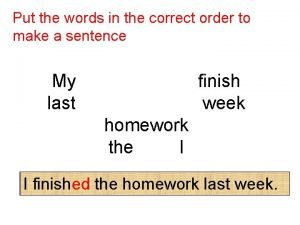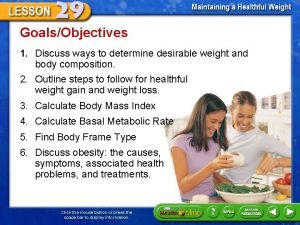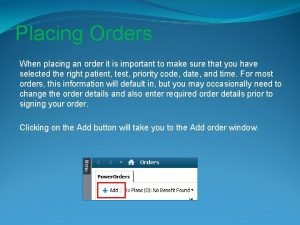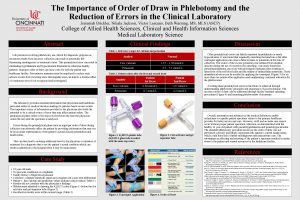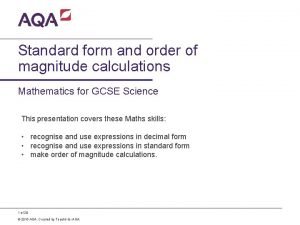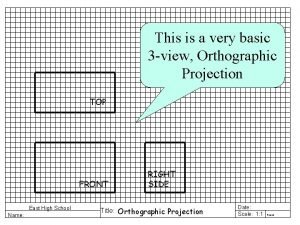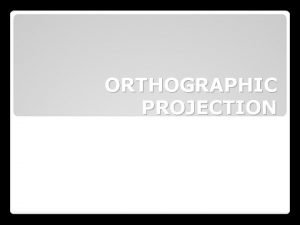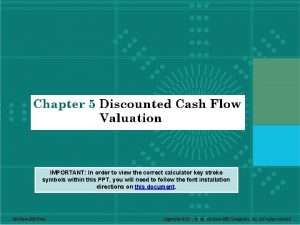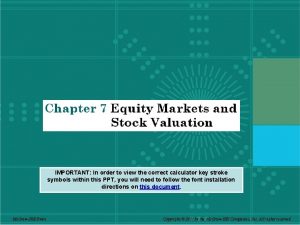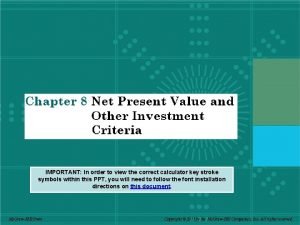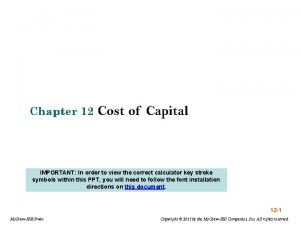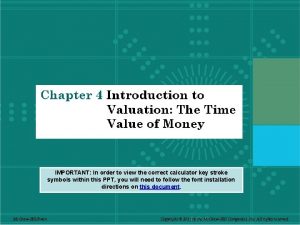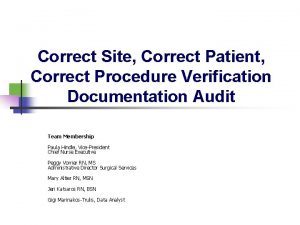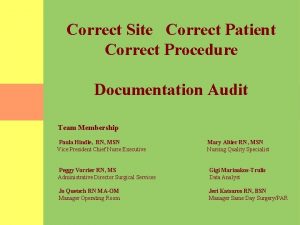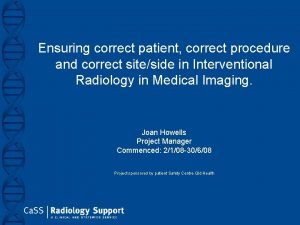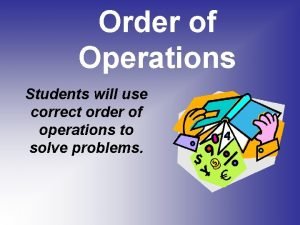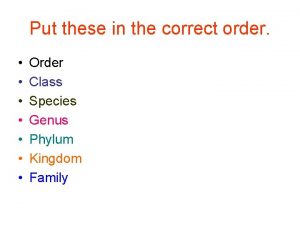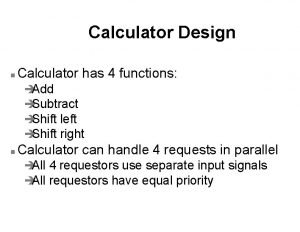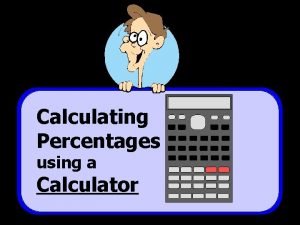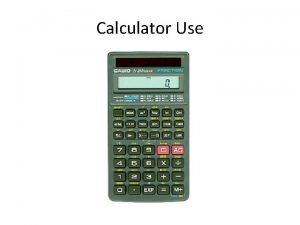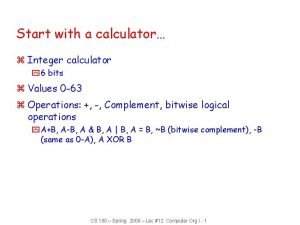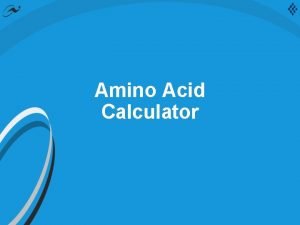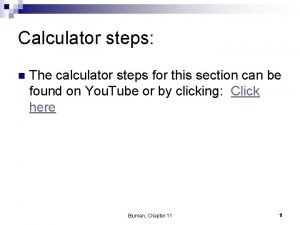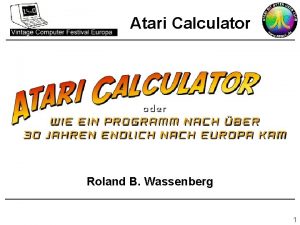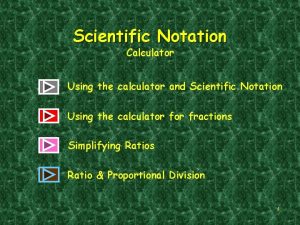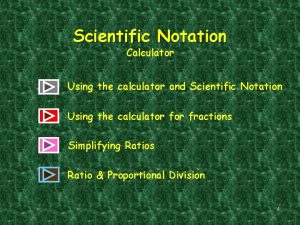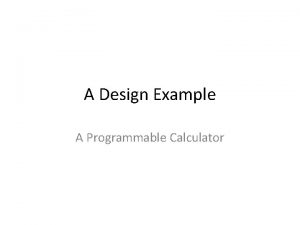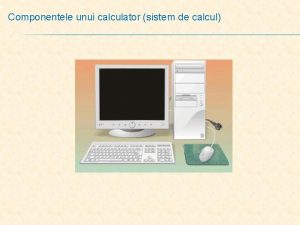IMPORTANT In order to view the correct calculator

























































- Slides: 57

IMPORTANT: In order to view the correct calculator key stroke symbols within this PPT, you will need to follow the font installation directions on this document. 6 -1 Mc. Graw-Hill/Irwin Copyright © 2011 by the Mc. Graw-Hill Companies, Inc. All rights reserved.

Key Concepts and Skills • Know the important bond features and bond types • Understand: – Bond values and why they fluctuate – Bond ratings and what they mean – The impact of inflation on interest rates – The term structure of interest rates and the determinants of bond yields 6 -2

Chapter Outline 6. 1 6. 2 6. 3 6. 4 6. 5 6. 6 6. 7 Bonds and Bond Valuation More on Bond Features Bond Ratings Some Different Types of Bonds Bond Markets Inflation and Interest Rates Determinants of Bond Yields 6 -3

Bond Definitions • Bond – Debt contract – Interest-only loan • • • Par value (face value) ~ $1, 000 Coupon rate Coupon payment Maturity date Yield to maturity 6 -4

Key Features of a Bond • Par value: – Face amount – Re-paid at maturity – Assume $1, 000 for corporate bonds • Coupon interest rate: – Stated interest rate – Usually = YTM at issue – Multiply by par value to get coupon payment 6 -5

Key Features of a Bond • Maturity: – Years until bond must be repaid • Yield to maturity (YTM): – The market required rate of return for bonds of similar risk and maturity – The discount rate used to value a bond – Return if bond held to maturity – Usually = coupon rate at issue – Quoted as an APR 6 -6

Bond Value • Bond Value = PV(coupons) + PV(par) • Bond Value = PV(annuity) + PV(lump sum) • Remember: – As interest rates increase present values decrease ( r → PV ) – As interest rates increase, bond prices decrease and vice versa 6 -7

The Bond-Pricing Equation PV(Annuity) PV(lump sum) C = Coupon payment; F = Face value Return to Quiz 6 -8

Texas Instruments BA-II Plus , = number of periods to maturity • - = period interest rate = YTM. = present value = bond value / = coupon payment 0 = future value = face value = par value n , / - . 0 6 -9

Spreadsheet Formulas =FV(Rate, Nper, Pmt, PV, 0/1) =PV(Rate, Nper, Pmt, FV, 0/1) =RATE(Nper, Pmt, PV, FV, 0/1) =NPER(Rate, Pmt, PV, FV, 0/1) =PMT(Rate, Nper, PV, FV, 0/1) • Inside parens: (RATE, NPER, PMT, PV, FV, 0/1) • “ 0/1” Ordinary annuity = 0 (default) Annuity Due = 1 (must be entered) 6 -10

Pricing Specific Bonds on the TI BAII+ • Bond Worksheet: &l • SDT CPN RDT RV ACT 2/Y YLD PRI – – – – SDT = Actual Settlement date (MM. DD. YY) CPN = Annual rate in % RDT = Actual Redemption (maturity) date RV = Redemption value as a % of par ACT = ACT/360 day count setting 2/Y = 2/Y – 1/Y coupons per year YLD = Yield to redemption PRI = Dollar price per $100 of par value 6 -11

Pricing Specific Bonds in Excel =PRICE(Settlement, Maturity, Rate, Yld, Redemption, Frequency, Basis) =YIELD(Settlement, Maturity, Rate, Pr, Redemption, Frequency, Basis) – Settlement = actual date as a serial number – Maturity = actual date as a serial number – Redemption and Pr(ice) = % of par value – Rate (coupon) and Yld = annual rates as decimals – Frequency = # of coupons per year – Basis = day count convention 6 -12

Valuing a Discount Bond with Annual Coupons • • • Coupon rate = 10% Annual coupons Par = $1, 000 Maturity = 5 years YTM = 11% Using the calculator: 5 , 11 100 / 1000 0 %. -963. 04 Using the formula: B = PV(annuity) + PV(lump sum) B = 369. 59 + 593. 45 = 963. 04 Using Excel: =PV(0. 11, 5, 1000, 0) Note: When YTM > Coupon rate Price < Par = “Discount Bond” 6 -13

Valuing a Premium Bond with Annual Coupons • • • Coupon rate = 10% Annual coupons Par = $1, 000 Maturity = 20 years YTM = 8% Using the calculator: 20 , 8 100 / 1000 0 %. -1, 196. 36 Using the formula: B = PV(annuity) + PV(lump sum) B = 981. 81 + 214. 55 = 1196. 36 Using Excel: =PV(0. 08, 20, 1000, 0) Note: When YTM < Coupon rate Price > Par = “Premium Bond” 6 -14

Bond Price Graphical Relationship Between Price and Yield-to-maturity 6 -15

Bond Prices: Relationship Between Coupon and Yield • Coupon rate = YTM Price = Par • Coupon rate < YTM Price < Par – “Discount bond” … Why? • Coupon rate > YTM Price > Par – “Premium bond” … Why? 6 -16

Bond Value ($) vs Years remaining to Maturity Premium CR>YTM = CR 1, 000 M CR<YTM Discount 30 25 20 15 10 5 0 6 -17

The Bond-Pricing Equation Adjusted for Semi-annual Coupons C = Annual coupon payment C/2 = Semi-annual coupon YTM = Annual YTM (as an APR) YTM/2 = Semi-annual YTM t = Years to maturity 2 t = Number of 6 -month periods to maturity 6 -18

Semiannual Bonds Example 6. 1 • Coupon rate = 14% - Semiannual • YTM = 16% (APR) • Maturity = 7 years – Number of coupon payments? • 14 = 2 x 7 years – Semiannual coupon payment? • $70 = (14% x Face Value)/2 – Semiannual yield? • 8% = 16%/2 (t or , ) (C or /) (YTM or -) 6 -19

Example 6. 1 • Semiannual coupon = $70 • Semiannual YTM = 8% • Periods to maturity = 14 • Bond value = • 70[1 – 1/(1. 08)14] /. 08 + 1000 / (1. 08)14 = 917. 56 Using the calculator: 14 , 8 70 / 1000 0 %. -917. 56 Using Excel: =PV(0. 08, 14, 70, 1000, 0) 6 -20

Interest Rate Risk • Price Risk – Change in price due to changes in interest rates – Long-term bonds have more price risk than short-term bonds – Low coupon rate bonds have more price risk than high coupon rate bonds 6 -21

Interest Rate Risk • Reinvestment Rate Risk – Uncertainty concerning rates at which cash flows can be reinvested – Short-term bonds have more reinvestment rate risk than long-term bonds – High coupon rate bonds have more reinvestment rate risk than low coupon rate bonds 6 -22

Figure 6. 2 6 -23

Computing Yield-to-Maturity YTM • Yield-to-maturity (YTM) = the market required rate of return implied by the current bond price • With a financial calculator, – Enter , , . , /, and 0 – Remember the sign convention • / and 0 need to have the same sign (+) • . the opposite sign (-) • %6 -24

YTM with Annual Coupons Consider a bond with a 10% annual coupon rate, 15 years to maturity and a par value of $1000. The current price is $928. 09. – Will the yield be more or less than 10%? 15 928. 09 1000 100 %- , S. 0 / = 11% Result = YTM Using Excel: =RATE(15, 100, -928. 09, 1000, 0) 6 -25

YTM with Semiannual Coupons Suppose a bond with a 10% coupon rate and semiannual coupons, has a face value of $1000, 20 years to maturity and is selling for $1197. 93. – Is the YTM more or less than 10%? – What is the semiannual coupon payment? – How many periods are there? 6 -26

YTM with Semiannual Coupons Suppose a bond with a 10% coupon rate and semiannual coupons, has a face value of $1, 000, 20 years to maturity and is selling for $1, 197. 93. 40 , NOTE: Solving a semi 1197. 93 S. annual payer for YTM results in a 6 -month YTM. 1000 0 The calculator & Excel 50 / solve what you enter. %4% YTM = 4%*2 = 8% Result = ½ YTM Using Excel: =RATE(40, 50, -1197. 93, 1000, 0) = 4% 6 -27

Table 6. 1 6 -28

Debt versus Equity • Debt – – Not an ownership interest No voting rights Interest is tax-deductible Creditors have legal recourse if interest or principal payments are missed – Excess debt can lead to financial distress and bankruptcy • Equity – Ownership interest – Common stockholders vote to elect the board of directors and on other issues – Dividends are not tax deductible – Dividends are not a liability of the firm until declared. Stockholders have no legal recourse if dividends are not declared – An all-equity firm cannot go bankrupt 6 -29

The Bond Indenture “Deed of Trust” Contract between issuing company and bondholders includes: – Basic terms of the bonds – Total amount of bonds issued – Secured versus Unsecured – Sinking fund provisions – Call provisions • Deferred call • Call premium – Details of protective covenants Return 6 -30 to Quiz

Bond Classifications • Registered vs. Bearer Bonds • Security – Collateral – secured by financial securities – Mortgage – secured by real property, normally land or buildings – Debentures – unsecured – Notes – unsecured debt with original maturity less than 10 years • Seniority – Senior versus Junior, Subordinated 6 -31

Bond Characteristics and Required Returns • Coupon rate – (risk characteristics of the bond when issued) – Usually ≈ yield at issue • Which bonds will have the higher coupon, all else equal? – – Secured debt versus a debenture Subordinated debenture versus senior debt A bond with a sinking fund versus one without A callable bond versus a non-callable bond 6 -32

Bond Ratings – Investment Quality • High Grade – Moody’s Aaa and S&P AAA – capacity to pay is extremely strong – Moody’s Aa and S&P AA – capacity to pay is very strong • Medium Grade – Moody’s A and S&P A – capacity to pay is strong, but more susceptible to changes in circumstances – Moody’s Baa and S&P BBB – capacity to pay is adequate, adverse conditions will have more Return impact on the firm’s ability to pay to Quiz 6 -33

Bond Ratings - Speculative • Low Grade – Moody’s Ba, B, Caa and Ca – S&P BB, B, CCC, CC – Considered speculative with respect to capacity to pay. The “B” ratings are the lowest degree of speculation. • Very Low Grade – Moody’s C and S&P C – income bonds with no interest being paid – Moody’s D and S&P D – in default with principal and interest in arrears 6 -34

Government Bonds • Municipal Securities – Debt of state and local governments – Varying degrees of default risk, rated similar to corporate debt – Interest received is tax-exempt at the federal level – Interest usually exempt from state tax in issuing state 6 -35

Government Bonds • Treasury Securities = Federal government debt – Treasury Bills (T-bills) • Pure discount bonds • Original maturity of one year or less – Treasury notes • Coupon debt • Original maturity between one and ten years – Treasury bonds • Coupon debt • Original maturity greater than ten years 6 -36

Example 6. 4 A taxable bond has a yield of 8% and a municipal bond has a yield of 6% • If you are in a 40% tax bracket, which bond do you prefer? – 8%(1 -. 4) = 4. 8% – The after-tax return on the corporate bond is 4. 8%, compared to a 6% return on the municipal • At what tax rate would you be indifferent between the two bonds? – 8%(1 – T) = 6% – T = 25% 6 -37

Zero Coupon Bonds • Make no periodic interest payments (coupon rate = 0%) • Entire yield-to-maturity comes from the difference between the purchase price and the par value (capital gains) • Cannot sell for more than par value • Sometimes called zeroes, or deep discount bonds • Treasury Bills and U. S. Savings bonds are good examples of zeroes 6 -38

Floating Rate Bonds • Coupon rate floats depending on some index value • Examples – adjustable rate mortgages and inflation-linked Treasuries • Less price risk with floating rate bonds – Coupon floats, so is less likely to differ substantially from the yield-to-maturity • Coupons may have a “collar” – the rate cannot go above a specified “ceiling” or below a specified “floor” 6 -39

Other Bond Types • • Income bonds Convertible bonds Put bonds Many types of provisions can be added to a bond – Important to recognize how these provisions affect required returns – Who does the provision benefit? 6 -40

Bond Markets • Primarily over-the-counter transactions with dealers connected electronically • Extremely large number of bond issues, but generally low daily volume in single issues • Getting up-to-date prices difficult, particularly on small company or municipal issues • Treasury securities are an exception 6 -41

Work the Web Example • Bond information is available online • One good site: http: //cxa. marketwatch. com/finra/Bond. Center • Click on the web surfer to go to the site – Use “Quick Bond Search” to observe the yields for various bond types, and the shape of the yield curve. 6 -42

Corporate Bond Quotations ABC 8. 375 J ul 15, 2033 100. 641 8. 316 362 30 763, 528 – What company are we looking at? – What is the coupon rate? If the bond has a $1000 face value, what is the coupon payment each year? – When does the bond mature? – What was the trading volume on that day? – What is the quoted price? (Ask price) – How does the bond’s yield compare to a comparable Treasury note/bond? • 8. 316 = Last yield • 362 = basis point difference vs 30 -yr T-Bond 6 -43

Treasury Quotations • Highlighted quote in Figure 6. 3 2020 Feb 15 8. 5 145. 12 145. 15 +64 3. 4730 – – – When does the bond mature? What is the coupon rate on the bond? What is the bid price? What does this mean? What is the ask price? What does this mean? How much did the price change from the previous day? – What is the YTM based on Ask price? 6 -44

Treasury Quotations 2020 Feb 15 8. 5 145. 12 145. 15 +64 3. 4730 – Maturity = Feb 15, 2020 – Coupon rate = 8. 5% per year – Bid price = 145: 12 = 145 12/32 % of par • Price at which dealer is willing to buy from you – Ask price = 145: 15 = 145 15/32 % of par • Price at which dealer is willing to sell to you – Bid-Ask Spread = Dealer’s profit – Change = 64/32 nds • “Tick Size” = 1/32 – Asked Yield = 3. 4730% 6 -45

Quoted Price vs. Invoice Price • Quoted bond prices = “clean” price – Net of accrued interest • Invoice Price = “dirty” or “full” price – Price actually paid – Includes accrued interest • Accrued Interest – Interest earned since last coupon payment is owed to bond seller at time of sale 6 -46

Inflation and Interest Rates • Real rate of interest =Change in purchasing power • Nominal rate of interest = Quoted rate of interest, = Change in purchasing power and inflation • The ex ante nominal rate of interest includes our desired real rate of return plus an adjustment for expected inflation 6 -47

The Fisher Effect defines the relationship between real rates, nominal rates and inflation (1 + R) = (1 + r)(1 + h) R = nominal rate (Quoted rate) r = real rate h = expected inflation rate Approximation: R = r + h Return to Quiz 6 -48

Example 6. 6 If we require a 10% real return and we expect inflation to be 8%, what is the nominal rate? – R = (1. 1)(1. 08) – 1 =. 188 = 18. 8% – Approximation: R = 10% + 8% = 18% – Because the real return and expected inflation are relatively high, there is significant difference between the actual Fisher Effect and the approximation. 6 -49

Term Structure of Interest Rates • Term structure: The relationship between time to maturity and yields, all else equal – The effect of default risk, different coupons, etc. has been removed. • Yield curve: Graphical representation of the term structure – Normal = upward-sloping L/T > S/T – Inverted = downward-sloping L/T < S/T Return to Quiz 6 -50

Figure 6. 5 A – Upward-Sloping Yield Curve REPLACE with FIGURE 6. 5 A 6 -51

Figure 6. 5 B – Downward. Sloping Yield Curve 6 -52

Figure 6. 6 – Treasury Yield Curve 6 -53

Factors Affecting Required Return • Default risk premium – bond ratings • Taxability premium – municipal versus taxable • Liquidity premium – bonds that have more frequent trading will generally have lower required returns • Maturity premium – longer term bonds will tend to have higher required returns. Anything else that affects the risk of the cash flows to the bondholders will affect the required returns Return to Quiz 6 -54

Quick Quiz • How do you find the value of a bond and why do bond prices change? (Slide 6. 8) • What is a bond indenture and what are some of the important features? (Slide 6. 30) • What are bond ratings and why are they important? (Slide 6. 33) • How does inflation affect interest rates? (Slide 6. 48) • What is the term structure of interest rates? (Slide 6. 50) • What factors determine the required return on bonds? (Slide 6. 54) 6 -55

Chapter 6 END 6 -56

TI BA II+ Font Installation Close Powerpoint until the fonts are installed Print this page before closing Powerpoint Steps to installing the fonts using Windows XP or Vista: • Go to this link: http: //education. ti. com/educationportal/downloadcenter/Software. Detail. do? website=US&app. Id=61 61 • Download and [Save] the Windows designated file to your hard drive. Do not [Run] the file you are attempting to download. • Unzip the file to a location that you can easily navigate to on your computer (I’d advise using your desktop for this). Unzip by double clicking the file, choosing browse in the window that pops up, and then setting your unzip location to your desktop by selecting desktop. • You’ll have 4 files on your laptop. Two of them will have Icons ~ you’ll need to use these. • Go to “Start” “Control Panel” “Fonts. ” You can drag and drop the font file into your font folder or select “File” “Install New Font” and indicate the location of the icon files • Restart Power. Point, and open the slideshow you were attempting to view. Steps to installing the fonts on a Mac: • Go to this link: http: //education. ti. com/educationportal/downloadcenter/Software. Detail. do? website=US&app. Id=61 61 • Download the Mac designated file to your computer. • Double click the file that was downloaded. • Restart Power. Point 6 -57
 What is it important to put the words in the correct order
What is it important to put the words in the correct order 1st order 2nd order 3rd order neurons
1st order 2nd order 3rd order neurons Example of a news story
Example of a news story Inverted pyramid in news writing
Inverted pyramid in news writing Least important to most important
Least important to most important Desirable weight definition
Desirable weight definition 3rd person in a story
3rd person in a story Placing an order
Placing an order Order of draw importance
Order of draw importance Magnitude calculations
Magnitude calculations Hát kết hợp bộ gõ cơ thể
Hát kết hợp bộ gõ cơ thể Lp html
Lp html Bổ thể
Bổ thể Tỉ lệ cơ thể trẻ em
Tỉ lệ cơ thể trẻ em Chó sói
Chó sói Glasgow thang điểm
Glasgow thang điểm Hát lên người ơi alleluia
Hát lên người ơi alleluia Các môn thể thao bắt đầu bằng tiếng bóng
Các môn thể thao bắt đầu bằng tiếng bóng Thế nào là hệ số cao nhất
Thế nào là hệ số cao nhất Các châu lục và đại dương trên thế giới
Các châu lục và đại dương trên thế giới Công thức tính độ biến thiên đông lượng
Công thức tính độ biến thiên đông lượng Trời xanh đây là của chúng ta thể thơ
Trời xanh đây là của chúng ta thể thơ Mật thư anh em như thể tay chân
Mật thư anh em như thể tay chân Làm thế nào để 102-1=99
Làm thế nào để 102-1=99 Phản ứng thế ankan
Phản ứng thế ankan Các châu lục và đại dương trên thế giới
Các châu lục và đại dương trên thế giới Thể thơ truyền thống
Thể thơ truyền thống Quá trình desamine hóa có thể tạo ra
Quá trình desamine hóa có thể tạo ra Một số thể thơ truyền thống
Một số thể thơ truyền thống Cái miệng bé xinh thế chỉ nói điều hay thôi
Cái miệng bé xinh thế chỉ nói điều hay thôi Vẽ hình chiếu vuông góc của vật thể sau
Vẽ hình chiếu vuông góc của vật thể sau Nguyên nhân của sự mỏi cơ sinh 8
Nguyên nhân của sự mỏi cơ sinh 8 đặc điểm cơ thể của người tối cổ
đặc điểm cơ thể của người tối cổ Ví dụ về giọng cùng tên
Ví dụ về giọng cùng tên Vẽ hình chiếu đứng bằng cạnh của vật thể
Vẽ hình chiếu đứng bằng cạnh của vật thể Vẽ hình chiếu vuông góc của vật thể sau
Vẽ hình chiếu vuông góc của vật thể sau Thẻ vin
Thẻ vin đại từ thay thế
đại từ thay thế điện thế nghỉ
điện thế nghỉ Tư thế ngồi viết
Tư thế ngồi viết Diễn thế sinh thái là
Diễn thế sinh thái là Dot
Dot Thế nào là số nguyên tố
Thế nào là số nguyên tố Tư thế ngồi viết
Tư thế ngồi viết Lời thề hippocrates
Lời thề hippocrates Thiếu nhi thế giới liên hoan
Thiếu nhi thế giới liên hoan ưu thế lai là gì
ưu thế lai là gì Hươu thường đẻ mỗi lứa mấy con
Hươu thường đẻ mỗi lứa mấy con Khi nào hổ con có thể sống độc lập
Khi nào hổ con có thể sống độc lập Sơ đồ cơ thể người
Sơ đồ cơ thể người Từ ngữ thể hiện lòng nhân hậu
Từ ngữ thể hiện lòng nhân hậu Thế nào là mạng điện lắp đặt kiểu nổi
Thế nào là mạng điện lắp đặt kiểu nổi This orthographic view is directly above the front view
This orthographic view is directly above the front view Sectional views reveal
Sectional views reveal Broken-out section
Broken-out section Cutting plane line symbol
Cutting plane line symbol Bird's eye view angle
Bird's eye view angle Elevation orthographic drawing
Elevation orthographic drawing
